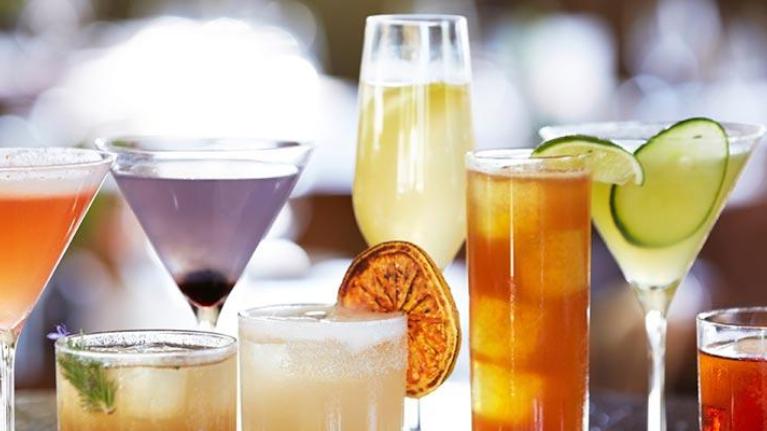
Beverage Trend Review
Pour on the profits with a revitalized beverage program. Discover the hottest trends in both alcoholic and nonalcoholic categories. We even have some ideas for housemade sodas that can add sparkle to your operation and your profits.
There’s a lot going on in the area of beverage—new products and concepts that are both exciting and profitable. In fact, anyone looking to build customer satisfaction and improve margins would do well to take a good hard look at their beverage program.
Alcoholic Beverages
Although there is no shortage of mega-proof cocktails—especially themes and variations on classics like the Negroni and the Manhattan—the biggest news may be the popularity of lower-proof options like aperitifs and cocktails made with wine and beer.
It makes good sense: Not only are these beverages safer for customers, they can also be ordered in multiples, yet they can support the same tariff as a Martini or a frozen specialty drink.
The roster includes:
-
Session beers (so called because their lower ABV allows drinkers to make a nightlong “session” of drinking them, in contrast to the high-proof extreme beers that have captured so much attention in years past)
-
Beer and wine cocktails, which use these sipping-friendly liquids as a base, rather than spirits; examples include the Michelada and one-off options such as the Bicycle Race at Ada Street, in Chicago (Riesling wine, Aperol, bitters and soda water)
-
Lower-proof fortified wines and spirits, such as sherry, bitter Amari (such as Campari and Cardamaro), hard cider, and specialty vermouth, either by themselves or mixed into signature cocktails like the Americano
Nonalcoholic Specialties
Like everything else these days, the big nonalcoholic beverage trend is all about the housemade, the artisanal, the small-batch, and the local. This ranges from virgin “cocktails” that feature sophisticated flavors built with house sodas, syrups, and even bitters, to drink menus that include local and regional favorites like Barq's and Manhattan Special.
At St. Eve’s restaurant in Ho-Ho-Kus, NJ, housemade sodas priced at $5-$7 are a huge draw in a rotating selection of flavors like Concord Grape and Jalapeno Ginger Ale. Colorful and refreshing, they tap into Americana-era nostalgia as well as growing customer demand for something that’s delicious and sophisticated but not a bit alcoholic—and, because the restaurant has no liquor license (customers are welcome to bring their own wine or beer), they are a great source of revenue. To add to the atmosphere, drinking water is carbonated tableside in an old-fashioned soda siphon.
TIP: Looking for more beverage trends and news? Subscribe to SmartBrief newsletters covering both the overall beverage industry and nonalcoholic beverages.
Watch for These Other Beverage Trends
-
Bigger and Better Bloody Marys, with more garnishes and flourishes (at Mike Ditka’s, in Chicago, the top-selling Bloody Mike features Absolut Peppar vodka, the “Coach’s” bloody Mix, and a shrimp-and-vegetable skewer garnish).
-
Barrel-Aged Cocktails (batch-producing and aging a popular cocktail is a great marketing ploy, and a boon to operations because the drink is ready-made).
-
Wine on Tap, joining the ever-growing selection of tap beers.
-
"Kitchen Cocktails” including ingredients like muddled cucumber, fresh herbs, berries and other distinctive fruits, florals such as hibiscus, and other items normally associated with the food menu.
-
Artisanal Spirits, including gin, rum, and whiskies from micro-distilleries and other small-batch producers—especially if they’re local.
-
Global Specialties, such as Danish aquavit, Brazilian cachaça, and absinthe from France and Switzerland.
-
Tea Takes Off—Again (hot or cold, on its own or mixed into cocktails, this once-fusty beverage is becoming more popular among Millennials and others in-the-know).
-
Multiple Choice (sophisticated cocktail programs have moved way beyond the usual well-and-premium selection—at Cata, in New York City, for instance, there are 24 different Gin & Tonics on offer, each matching the characteristics of one specific gin to its tonic and garnishes).
-
Smoke and Mirrors (smoky elements like Scotch, tea, and even ice cubes made from water that has been smoked are showing up on the cocktail-trend radar).
Gone are the days of just three different glasses at the bar (hi-ball, double old-fashioned, and martini). Ambitious cocktail lists deserve a selection of glassware that can complement everything from cordials and sherry to tiki drinks—some savvy mixologists even collect vintage coupes and other glassware, the better to show off signature drinks. In addition to being emblematic of most of the trends presented here, the cocktail menu at the new Marco’s, in Brooklyn, N.Y., illustrates how much glassware and garnishes can add to the premium appeal of cocktails—even “on the rocks” drinks are served in everything from DOFs to elegant stemware.
